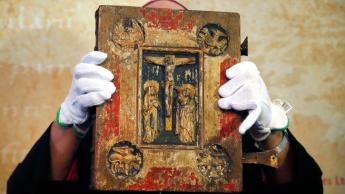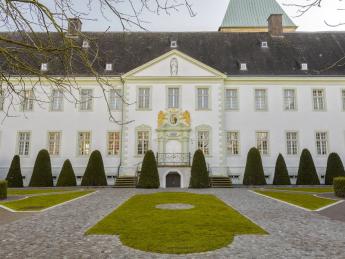Germany buys back 1000-Year old Liesborn Gospels

Printing with movable types was only invented 500 years later, the Liesborn Gospel from the year 980, one of the oldest manuscripts still in private possession has now returned to its original place, the diocese of Münster in Germany after a 3Mill Euro investment by the German state and a number of regional trusts.
The thousand-year-old Gospel Book of Liesborn Abbey in Westphalia has finally returned to its homeland, in a sale arranged between its present owners, the North American manuscript dealers and ILAB affiliates Les Enluminures, and a partnership between the Kreis Warendorf and the Sparkasse Münsterland Ost. Liesborn Abbey, in the diocese of Münster, was founded as a convent of nuns in the ninth century. This was their stately illuminated manuscript Gospel Book, their most precious possession. It was made around the year 980 by the scribe Gerwardus. The manuscript is richly decorated throughout with wonderful designs in red and yellow – by coincidence the municipal colours of the modern district of Warendorf. In the twelfth century the abbey was re-founded for monks.
The manuscript remained there until the monastery was closed in 1803. It was acquired by a professor at Hamm in Westphalia, who sold it to a famous English collector, Sir Thomas Phillipps. In 1950 it was presented to the library of a seminary in California, where it remained until 1987, when it was sold to a private collector in Norway. From there it was acquired by a private collection in Switzerland, from which it passed to Les Enluminures, of Chicago and New York. The manuscript comprises the four Gospels – Matthew, Mark, Luke and John, in the Latin translation of Saint Jerome. It is written and decorated on parchment, entirely by hand, more 500 years earlier than the Gutenberg Bible. It is in almost perfect condition and it survives in its medieval wooden binding, probably carved at Liesborn Abbey itself. It was until now one of the oldest manuscripts of the Gospels still in private possession.
Elisabeth Schwarm, director of the Museum Abtei Liesborn is keen to showcase this new, main attraction of the museum to the public from 2019 on and noted during a presentation:
“This manuscript has travelled international collections for centuries, so it is our great fortune that it is now finally back in Liesborn.”
“Professional valuations were done and the manuscript was estimated at 3 million Euros. Therefore, we were not allowed to spend a cent more.” says local councilor Olaf Gericke about the time of the negotiations with the American booksellers Sandra Hindman.
Funding came from the German Bundesregierung, the diocese of Paderborn and a number of trusts from the region.
The Liesborn Gospels is of exceptional condition, “All collectors wanted to maintain its value and have treated it very carefully.” adds the museum’s director.
The museum covers historical artefacts from the medieval age and Renaissance through to contemporary craftsmanship from the region.
Sandra Hindman is the proprietor of Les Enluminures, manuscript dealers with offices in Chicago, New York, Paris and London and affiliates of the International League of Antiquarian Booksellers.
Extract from the official Les Enluminures Press Release, March 2017:
They (Les Enluminures, ed.) are advisors and agents for many national libraries and museums. “It is always a source of very great satisfaction when a manuscript finally returns to its rightful and ancestral home”, said Professor Sandra Hindman, founder and president of Les Enluminures. The sale was negotiated by her and by Dr Christopher de Hamel, of Cambridge University and a senior vice-president of Les Enluminures. Dr de Hamel, then representing Sotheby’s, had been responsible for the sale of the Gospel Book of Henry the Lion to the German state in 1983. “Now, more than ever, the treasures of ancient Europe are precious reminders of our history,” Dr de Hamel added. The state of Westphalia had unsuccessfully attempted to reacquire the manuscript several times in the past. The purchase now was due to the effort and unrelenting enthusiasm of Dr Olaf Gericke, Landrat of the Kreis Wardendorf, and his colleagues.
Image credits:
Image 1 & 2: The Liesborn gospel, image source: dpa
Image 3: Museum Abtei Liesborn, image source: Museum website


